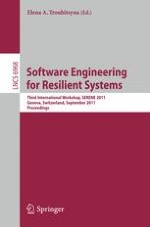This book constitutes the refereed proceedings of the Third International Workshop on Software Engineering for Resilient Systems, SERENE 2011, held in Geneva, Switzerland, in September 2011.
The 13 revised full papers presented together with 2 invited talks were carefully reviewed and selected from numerous submissions. The papers address all aspects of formal modeling and verification, architecting resilient systems, fault tolerance, requirements engineering and product lines, monitoring and self-adaption, and security and intrusion avoidance.
